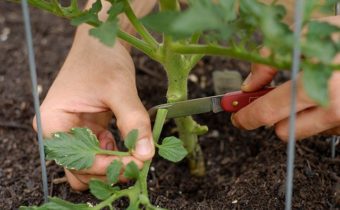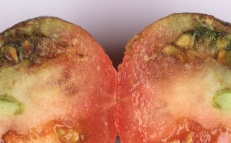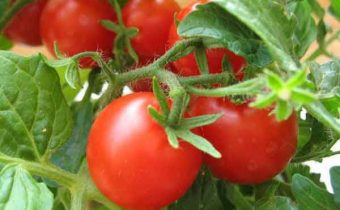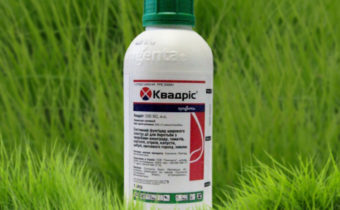What is tomato anthracosis and how to cure it in a greenhouse
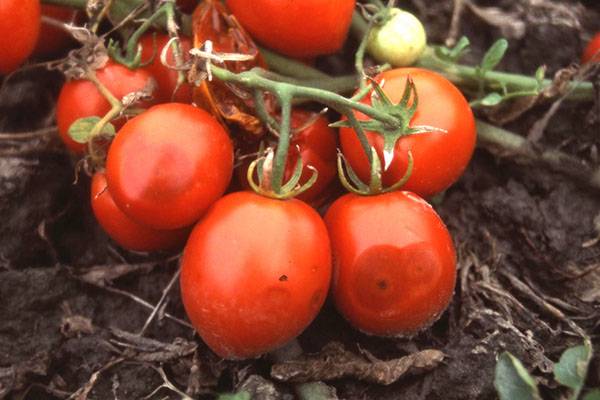
Many garden and horticultural crops are vulnerable to anthracnose, but most often the disease affects tomatoes. In most cases, the disease manifests itself by the end of the summer, during the period of fruiting, and may cause a large crop loss.
Manifestations of anthracnose in tomatoes
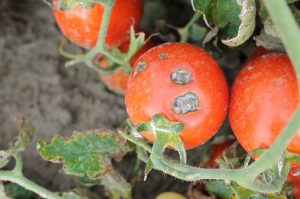
Tomatoes are characterized by the defeat of fruits, roots and root collar by an anthracnose, but the disease can appear on all parts of the plant.
- Fruit. The anthracnose lesion of fruits is asymptomatic until the time of ripening of vegetables. On the surface of a ripe tomato are formed round, like "depressed" spots, initially not different in color from the skin. Over time, the damaged areas grow and darken, becoming almost black in color. In the central part of the spot an area of yellow-brown color with a large number of dark patches is formed. The fruit tissues in these areas soften and rot, the pulp acquires a bitter taste. Eat affected vegetables in food is impossible.
- Root system At the beginning of the disease brown-brown, scaly areas appear on the roots. The tissues in the affected areas begin to soften, gradually the process covers the entire root, so that the plant can be pulled out of the soil without effort by pulling the stem. Affected plants exhibit symptoms characteristic of damage to the roots - growth inhibition, weakening, twisting, yellowing and wilting of leaves, dropping of flowers and ovaries, weak growth of fruits. If the bush does not receive treatment, it dies.
- Leaves and stems. On the lower leaves, stem and shoots of tomatoes appear, gradually increasing in size, reddish-brown spots with dark or yellow border along the edge. On the leaves, as a rule, several damaged areas are formed at once, which, growing, coalesce, as a result of which the leaf dries out. As the spots grow, they darken and deepen, rotting, the areas of the stems and shoots around them become brown-brown or purple. As a result of the defeat of the stem, the movement of the juices over the plant becomes difficult. Even if there is no infection of the fruit, sick bushes cannot give a good harvest.
If a sign of anthracnose appeared on the ripe fruits of tomatoes, it means that unripe vegetables on the bush are also infected. But subject to systemic planting treatments, the crop can still be saved.
Causes of Anthracnose
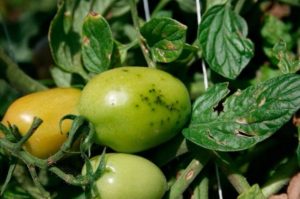
The disease causes the fungus Colletotrichum coccodes. The disease may not appear for a long time, even if the plants are already infected. The impetus to the active development of anthracnose is the weakening of tomatoes due to maintenance disorders, mechanical damage to the bushes, lack of nutrition, primarily deficiency of phosphorus and potassium, cultivation on acidic soils.
The most favorable conditions for the fungus are high air humidity (85-95%) and a temperature of about + 20 ... + 25 ° C. This makes tomatoes in the greenhouse particularly vulnerable to illness. The pathogen can get into the greenhouse along with the soil, manure, water, air during ventilation, insects. Tomato seeds can be infected with anthracnose.
The fungus overwinters in dormant form (sclerotia) in the soil or on plant residues.Many cultures - pepper, eggplants, potatoes, cucumbers, beans, strawberries, raspberries, gooseberries, currants, grapes, cherries, watermelons, and melons - are subject to anthracnose disease. Carriers of the fungus can be not only cultivated plants, but also weeds.
Treatment methods
The first therapeutic effect, which should be subjected to diseased tomatoes, is to remove the affected parts from the plants. Bushes affected by anthracnose to a large extent should be excavated and sanitized under them. After this, it is necessary to treat both diseased and still healthy tomato bushes with antifungal agents at least 2-3 times.
The procedure for treating the soil should be carried out after harvesting (the entire plot in the greenhouse, regardless of the spread of the disease), and also disinfect the design of the shelter itself. To destroy the fungus in the soil, it is recommended to treat it with the preparation “Thiovit Jet”. It is necessary to dilute 100 g of the product in 3 liters of water and spray the solution with soil. This volume is enough for an area of 10m2. For disinfection greenhouses suitable bleach at the rate of 200 g of the substance in a bucket of water.
Treatment during ripening
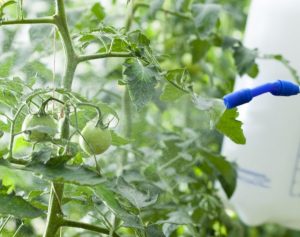
As in the case of other fungal diseases, the treatment of plants with fungicides is effective against anthracnose. Since the lesion on the fruits of tomatoes is detected only during the fruiting period, not all chemical agents are suitable for spraying.
During this period it is recommended to use drugs:
- Tiovit Jet. Contact fungicide (that is, it does not penetrate the plant tissue), the active ingredient is sulfur. After processing, harvest is allowed in a day. For spraying 1 hundred tomato beds, 50 grams of the product should be diluted in a bucket of water.
- Colloidal sulfur. The analogue of the drug "Tiovit Jet" is used in the same way, but less effective due to a shorter period during which the product is kept on plants and, accordingly, acts on the fungus.
- "Kvadris." Systemic fungicide, but with a short period of elimination of toxic substances from the tissues of the fruit. Tomatoes can be harvested 5 days after processing. For spraying 1 weave you need to dissolve 6 ml of the drug in 10 liters of water.
Treatment with preparations containing sulfur should be carried out strictly on a dry leaf. Apply no earlier than 2 weeks after spraying with oil-based products.
A single chemical treatment will not be enough, one of these means (or alternating them) should be processed tomatoes three times with an interval of 2 weeks.
Effective folk remedies for anthracnose tomatoes do not exist, but there is a safe alternative to chemical fungicides - biological products, they can be used at any phase of plant development. These funds will not be able to cure the affected bushes, but will prevent the spread of the disease by planting.
Against anthracnose use bacterial preparations:
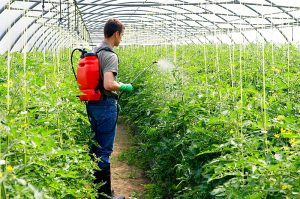
- "Hamair". For processing tomatoes need to dissolve 10 tablets in 10 liters of water. During spraying the solution should be constantly stirred.
- "Alirin-B". It is not used from anthracnose as an independently acting agent, but it significantly enhances the effect of “Gamair”, if you mix these drugs. To prepare the mixture, both products are diluted with a small volume of water separately from each other, after which the liquids are drained into one container and diluted with water, bringing to the desired concentration.
- "Fitosporin-M". The drug is diluted depending on the form of the agent (indicated in the instructions), but always in warm water, so that bacteria can be activated, however, not hotter than 35 ° C, otherwise the beneficial microorganisms will die. In order to awaken bacteria, the prepared solution should also be allowed to stand under the lid for at least 2 hours.
Processing at the beginning of the growing season
If the damage to the roots or the green part of the plants is found before the fruit formation phase, the list of fungicides that can be used is much wider.
The most effective anti-anthracnogenic drugs:
- "Poliram".Contact fungicide of organic origin. Processing of tomatoes can be carried out before the first ovaries on the bushes with intervals of 20 days, no more than 3 times per season. For spraying 1 weave, 25 g of the substance must be diluted in 6 liters of water.
- Ridomil Gold. The system-contact fungicide provides the plant with comprehensive protection. Spraying tomatoes can be carried out in the initial phase of the growing season and during budding, but not more than 3 times. For the treatment of hundreds of beds requires 25 g of the substance, diluted with 5 liters of water.
- "Revus Top". It is recommended to use for the treatment of tomatoes during the flowering period, the drug is particularly effective after the use of "Ridomil Gold" (in the earlier phase). A total of 3 treatments of tomatoes are allowed, the consumption rate per 100m2 is 6 ml of product per 5 liters of water.
- "Fast". Systemic drug with a long term protection. It is derived from plant tissue for 2 weeks. For processing 1 hundred squares of tomato beds it is required to dilute 2 ml of the preparation in 5 liters of water. No more than 3 sprays during the growing season.
- Bordeaux fluid. Processing can be carried out before the formation of ovaries, no more than 3 times with a break of 10-15 days. For spraying tomatoes use a 1% solution of funds, consumption per weave is 5-10 liters.
- Chloroxide copper. It is undesirable to use during the flowering period, processing is allowed between the flowering of the first and second brushes, the last application is no later than 20 days before the fruit are picked. 3-5 treatments are allowed with breaks of 10-14 days. In 10 liters of solution (volume for 1 hundred) it is necessary to dissolve 40 g of the substance.
Prevention
Preventive measures against anthracnose, as a rule, show good results. For the prevention of disease using agrotechnical techniques and seed and plant processing.
It is worth paying attention to the varieties of tomatoes that are resistant to anthracnose - "Onyx", "Shelf F1", "Polyus", "Longf F1", "Life F1".
The basic rules of agrotechnology in the greenhouse against anthracnose:
- Do not allow excessive soil moisture.
- Do not resort to irrigation by sprinkling.
- To carry out loosening after each watering.
- Regularly clean the beds from weeds.
- Control the air humidity in the greenhouse (airing).
- Tie up the bushes of tomatoes.
To prevent the occurrence of anthracnosis, preventive treatments are recommended:
- Soaking the seeds before sowing in a solution of the fungicide. In this case, the “Immunocytofit” and “Agat-25” products are effective.
- Spraying of seedlings at the stage of 2 leaves with the preparation “Agat-25”.
- Watering holes the day before planting in the greenhouse with 1% solution of copper sulfate (1 liter per well).
- Processing of tomatoes before flowering with biological products and chemical means, such as "Poliram", "Kvadris", "Strobe", copper oxychloride, Bordeaux liquid, copper sulphate.
Anthracnose is especially unpleasant because it often appears during the beginning of the harvest, when the gardener has his hands tied. Despite the unconditional harm of chemical agents, comparing the risks of such treatment at the beginning of the growing season and during the fruiting of tomatoes, it is necessary to recognize the appropriate preventive treatment in the early period of plant development.


